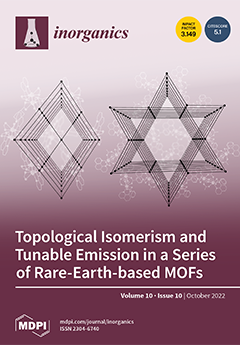Chloranilic acid (2,5-dichloro-3,6-dihydroxy-1,4-benzoquinone, caH
2) as a bidentate ligand for Nb(V) as a metal center is presented. The different coordination behavior of caH
2 is well illustrated by a monomeric (Et
4N)
cis-[NbO(ca)
2(H
2O)OPPh
3]·3H
2
[...] Read more.
Chloranilic acid (2,5-dichloro-3,6-dihydroxy-1,4-benzoquinone, caH
2) as a bidentate ligand for Nb(V) as a metal center is presented. The different coordination behavior of caH
2 is well illustrated by a monomeric (Et
4N)
cis-[NbO(ca)
2(H
2O)OPPh
3]·3H
2O.THF (
5) and a novel tetranuclear compound (Et
4N)
4[Nb
4O
4(ca)
2(
μ2-O)
2Cl
8]·2CH
3CN (
6) via self-assembly, respectively. These were obtained in >80% yields and characterized by IR, UV/Vis and NMR (
1H,
13C{
1H},
31P{
1H}) spectroscopy and single crystal X-ray diffraction, and they included a systematic assessment of the solid-state behavior. The anionic metal complexes showed different coordination modes at the Nb(V): [Nb
4O
4(ca)
2(
μ2-O)
2Cl
8]
4− (
6a; distorted octahedral) and
cis-[NbO(ca)
2(H
2O)(OPPh
3)]
− (
5a;
D5h distorted pentagonal bipyramidal), respectively. The tetranuclear complex
6a is substitution inert, while
cis-[NbO(ca)
2(H
2O)OPPh
3]
− (
5a) allowed a systematic ligation kinetic evaluation. The substitution of the coordinated triphenylphosphine oxide by a range of pyridine-type entering nucleophiles, 4-
N,
N-dimethyl-aminopyridine (DMAP), pyridine (py), 4-methylpyridine (4Mepy), 3-chloropyridine (3Clpy) and 3-bromopyridine (3Brpy) in acetonitrile at 31.2 °C was carefully evaluated. The subtle interplay between the main group ligand systems and the hard, early transition metal Nb(V) complex (
5a) was well illustrated. The entering monodentate ligands showed a 15-fold reactivity range increase in the order 3Brpy < 3Clpy < 4Mepy < py < DMAP in broad agreement with the Brønsted-donating ability of the nucleophiles. The activation parameters determined for the reaction of
5a with DMAP as the entering ligand yielded Δ
H≠kf = 52 ± 1 kJ mol
−1 and Δ
S≠kf = −108 ± 3 J K
−1 mol
−1 for the enthalpy and entropy of activation, respectively, indicating an associative substitution mechanism. The study presents an important contribution to the structure/reactivity relationships in Nb(V) complexes stabilized by chloranilic acid as a bidentate ligand.
Full article





